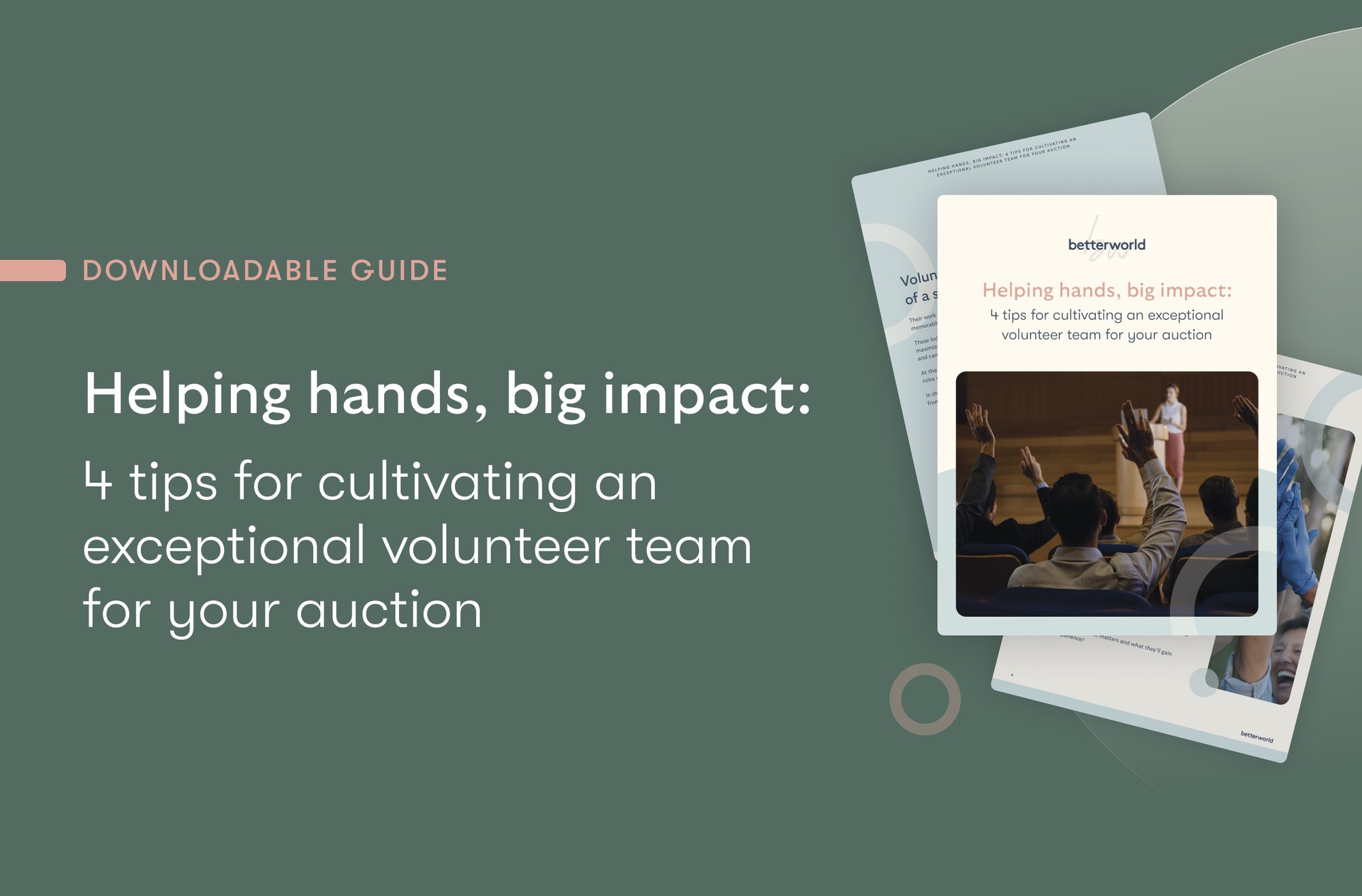Seamless online and in-person actions that raise more
Incredibly easy to set up, backed by an amazing support team
Thoughtful automations that save you dozens of hours
Thousands of dollars of “Instant Items” you can use in your auction at no cost
How To Set Perfect Starting Bids In Silent Auction?
By Colin Hunter

Setting the wrong starting bid in a silent auction can be disastrous. If it's too high, no one will bid. If it's too low, you might not raise enough funds.
That's why setting the right starting bid is one of the most important steps you can take. It can make or break your whole auction. This blog will show you how to set a perfect starting bid and ensure your auction succeeds. Let’s explore how to get it right from the start.
Understand Fair Market Value (FMV)
Your first step is to know the Fair Market Value (FMV) of each item. FMV is the price that someone would pay for an item when both the buyer and seller are informed and willing, without being forced to buy or sell.
This value helps you make sure your auction is both competitive and successful by setting a starting bid that is fair and appealing.
What is Fair Market Value?
Fair Market Value (FMV) is essentially the standard price for an item in the market. It's the price you might see similar items sell for on online platforms, in stores, or at other auctions.
Understanding this value ensures that the starting bids are reasonable—neither too high to scare away potential bidders nor too low to undersell the item.
Tips on Determining FMV for Different Types of Items
- Use the internet to look up what similar items are selling for. Websites like eBay, Amazon, and other online marketplaces give you a good sense of what people are willing to pay.
- For unique items like art, antiques, or collectibles, consider getting an appraisal from an expert. They can provide a detailed evaluation based on the item’s condition, rarity, and demand.
- Look at the final selling prices of similar items in previous auctions. Get an idea of what bidders might be willing to pay in a similar setting.
- The condition of an item plays a big role in its value. Make sure to adjust the price according to how well the item is preserved. Items in better condition should have a higher FMV.
- Understand your audience’s spending habits. If your auction attendees are generally looking for bargains, you might set the starting bids slightly lower to encourage bidding. On the other hand, if your audience is known for spending more on unique or luxury items, starting bids can be closer to the FMV.
Factors Influencing Starting Bids
After understanding the Fair Market Value (FMV) of your auction items, the next step is to consider other factors that can influence the starting bids.
1. Item Desirability and Uniqueness
Items with uniqueness or desirability can often fetch higher starting bids. For example, a signed sports memorabilia item from a renowned athlete or a rare piece of art has a unique appeal that can drive up its value.
When you have something special, bidders are usually willing to start bidding at a higher price because they understand the item's rarity or special value.
2. Guest Demographics and Spending Capacity
Knowing who is attending your auction can greatly influence how you set your starting bids.
Consider the typical income level, interests, and spending habits of your guests. If your guests are high earners who are passionate about the items being auctioned, such as collectors or enthusiasts, they might be more willing to place higher bids.
On the other hand, a more budget-conscious crowd might require lower starting bids to encourage participation.
3. Timing and Duration of the Auction Event
The timing of your auction can also affect starting bids. If your event coincides with paydays or a festive season, guests might be more inclined to spend freely.
Additionally, the length of the auction matters. Shorter auctions create a sense of urgency, prompting guests to bid quickly and possibly start at a higher bid to secure their desired item. Conversely, a longer auction might start with lower bids to keep the momentum going over time.
Setting the Right Starting Bids
Setting the right starting bids involves balancing low starting prices that encourage active bidding and maintaining high enough bids to ensure the items are sold at a value reflective of their worth.
Here’s how you can set these starting bids smartly.
Want to raise more from your auction? Try BetterWorld’s Auction Tool for FREE!
Recommended Starting Bid Percentages
A good rule of thumb for setting starting bids is to place them at about 30% to 35% of the item's Fair Market Value (FMV).
The exact percentage can depend on the nature of the item and the characteristics of your audience.
For more common items, a lower starting bid of around 25% can spark interest and encourage a competitive bidding environment.
Starting bids closer to 50% of the FMV might be more appropriate for more unique or high-demand items, as these items are likely to attract higher bids anyway.
Balancing Low and High Starting Bids
Set starting bids low enough to attract initial interest but high enough to suggest the item’s worth.
Lower starting bids can create an exciting dynamic, encouraging more bids as participants feel they are getting a good deal. It is a good way to start a bidding war to increase the final price.
On the other hand, starting too low might risk the item selling for less than its value if the bidding doesn’t pick up as expected. Setting a starting bid that accurately reflects the quality and desirability of the item encourages bidders to perceive it as valuable.
Bid Increments: Encouraging Continued Engagement
Setting the right bid increments in a silent auction is as important as determining the starting bids.
Let’s explore what bid increments are, why they’re important, and how to set them effectively to keep the bidding momentum going.
What is a Bid Increment in a Silent Auction?
A bid increment is the minimum amount by which a new bid must exceed the previous bid.
For example, if the current bid on an item is $100 and the bid increment is set at $10, the next minimum bid must be at least $110.
Importance of Setting the Right Bid Increments
The right bid increment encourages active participation by making it easy for bidders to increase their bids without feeling overwhelmed by large jumps in price.
It balances between making the bidding competitive and keeping the increments small enough to encourage more frequent bids. Properly set increments can increase the excitement and engagement of the auction. It also leads to higher final bids and more funds raised for your cause.
Recommended Increments Based on Item Value
The value of the item should guide how you set your bid increments:
- Items valued between $1 and $100: Set smaller increments, like $5 or $10. Smaller amounts are less intimidating for bidders.
- Items valued between $101 and $500: Consider increments of $10 to $25. These amounts are significant enough to represent a real increase but still manageable for most bidders
- Items valued over $500: Use larger increments, such as $50 to $100. Higher increments here make sense due to the higher starting bids and the perceived value of the items.
Handling Items Without a Clear FMV
It’s common to come across some unique items without a clear FMV while setting the starting bids in a silent auction. Here’s how to handle these cases.
- For truly unique items like artwork or antiques, consider getting an appraisal from a qualified expert who can provide a credible estimate of the item's worth.
- Look for similar items sold at other auctions or online marketplaces to gauge a potential starting point.
- Often, the donors of these items have a good understanding of their worth. Discussing with them can provide insights into how they value the item.
- Establish a minimum price that covers any costs associated with the item or that reflects its value as best understood, even if it's subjective.
10 Common Mistakes to Avoid When Setting a Starting Bid
- Not researching what similar items have sold for can lead to unrealistic starting prices.
- Overlooking the condition of an item can misrepresent its value and affect starting bids.
- Applying the same starting bid to a wide range of items can discourage interest in higher-value items.
- Basing starting bids solely on the cost of the item without considering perceived value can result in lost revenue.
- If the starting bids are too high for the financial reach of the attendees, you'll see less engagement.
- Ignoring feedback on starting bids from past auctions can lead to repeating the same mistakes.
- Unique does not always mean valuable to everyone. Overpricing unique items can lead to no bids.
- Not using strategic pricing, such as psychological pricing points ($19.99 instead of $20), can make bids less appealing.
- Low starting bids for expensive items can result in revenue loss if the item sells for much less than it is worth.
- Failing to adjust starting bids for the timing of the auction, such as holiday seasons or economic downturns, can impact bidder spending behavior.
Avoiding these mistakes will help you set more effective starting bids and ensure your silent auction is a success.
Take Your Silent Auction To The Next Level With Perfect Starting Bids
Setting the right starting bids for your silent auction might seem tricky at first, but with the guidelines outlined above, the process can be quite easy.
By avoiding common pitfalls and strategically pricing your items, you can create a perfect t bidding environment. Remember, the primary goal is to drive up bids as much as possible. Make the auction exciting and engaging for participants, and try to maximize the funds raised for your nonprofits.
With careful planning and attention to the preferences and capacities of your audience, you can ensure that your silent auction is a resounding success.

Join 105,000+ amazing nonprofits, organizations, and fundraisers on BetterWorld

Let our FREE fundraising tools help you raise more funds with less effort








